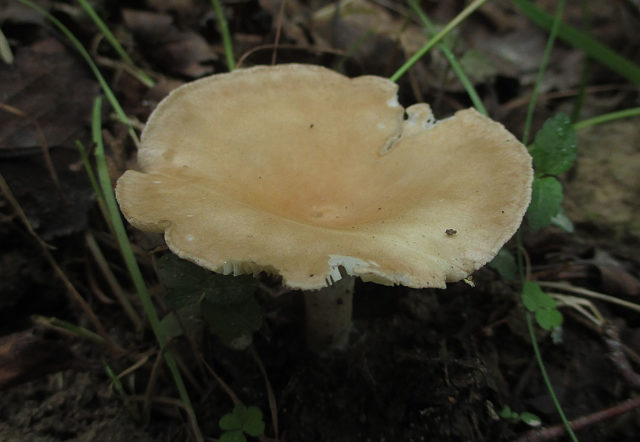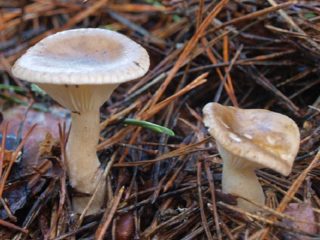Content
The genus Clitocybe, or Govorushka, includes more than 200 species. In Russia, there are no more than 60 species of them - edible and poisonous. The saucer-shaped talker is small in size and practically does not emit a mushroom aroma, which is why many mushroom pickers avoid it.
Where do saucer-shaped talkers grow?
Talkers grow throughout the temperate climate zone. They prefer deciduous and coniferous forests in the western part of Russia, Siberia and the Primorsky Territory.Populations of these fungi are also widespread in European countries, Belarus, Turkey, China, and in Asia - Eastern and Western. Saucer-shaped mushrooms are found in fields, meadows, along the edges of country roads and even in park areas.
What do saucer-shaped talkers look like?
Saucer-shaped talkers are small in size and snow-white in color. The cap, from 3 to 7 cm in diameter, in young specimens is flat and even, but during growth it becomes cup-shaped. Adult, overgrown representatives acquire a funnel-shaped, saucer-shaped shape, which explains the name of this representative of the fungal family. The caps have a dry, slightly matte and velvety surface of white, cream color, in some cases with a pinkish or yellowish color. The plates are very thin and smooth, with numerous small branches. The leg is from 4 to 6 cm in height towards the base, somewhat expanded. It may be slightly lighter in color than the cap. The surface of the stem is smooth, fibrous, slightly pubescent with velvety mycelium. The shape is cylindrical. The pulp is thin, snow-white, and does not change color when cut.
Is it possible to eat saucer-shaped talkers?
These mushrooms are classified as conditionally edible, so they can be eaten only after preliminary heat treatment. Before preparing culinary dishes, they are cleaned, sorted, washed and boiled. The broth is drained.
Taste qualities of the saucer-shaped govorushka mushroom
The saucer-shaped talker is not distinguished by its gastronomic value. Some experts claim that the mushroom has no special taste and aroma; others talk about the unpleasant taste of rancid flour and cottony, even somewhat fluffy pulp.When combining with other products, the spicy taste of mushrooms must be taken into account.
Benefits and harm to the body
The saucer-shaped govorushka is low-calorie, so it can be eaten during a diet. In addition, fruiting bodies contain a large amount of useful substances:
- The caps of young specimens are a real storehouse of macro- and microelements - zinc, copper, manganese, as well as B vitamins.
- The active substances contained in the composition remove toxins and waste from the human body and reduce the level of bad cholesterol in the blood.
- Eating pulp improves digestion and has a positive effect on the functioning of all gastrointestinal organs.
Saucer-shaped talkers have antibacterial properties, which explains their fairly widespread use in official and folk medicine. Medicinal decoctions help with diseases of the respiratory organs, in particular tuberculosis. And thanks to the presence of a substance such as clitocybin, mushrooms are used in drugs against epilepsy.
However, like most known mushrooms, talkers are capable of accumulating heavy metals and toxic compounds. Poisoning with them can be avoided if collected in environmentally friendly areas and prepared according to all the rules. Under no circumstances should you take fruiting bodies near roads, railways, or industrial enterprises.
False doubles
The most dangerous counterpart of the saucer-shaped talker is the whitish or discolored talker. It is small in size: its cap is up to 5 cm in diameter, its leg is up to 4 cm.It differs from its saucer-shaped relative in having a smooth, shiny surface, which in wet weather is covered with a small amount of mucus. In overgrown fruiting bodies, the stem becomes hollow. The whitish talker is a poisonous mushroom that is deadly to humans.
The video will clearly demonstrate how to distinguish talkers from each other:
Collection rules
Fruiting bodies are collected in dry weather from the end of June to the beginning of October. Only young specimens, whose diameter does not exceed 4-5 cm, are suitable for food. Only the caps are cut off, leaving the stem intact, and they are placed in a basket face down so that the mushrooms do not break during transportation.
Use
Only the caps of this type of mushroom are eaten: the stems become rubbery and hard when cooked. They are first boiled in a large amount of salted water for 30 minutes. When the caps sink to the bottom, they are ready. They are thrown into a colander and the water is allowed to drain. The decoction is not used for food. Prepared fruit bodies are fried in butter with the addition of onions or stewed.
Conclusion
Despite the fact that the saucer-shaped talker cannot compete in taste with mushroom species valued in gastronomy, it contains many useful properties and can be used in the preparation of medicines according to traditional medicine recipes. It is not recommended for inexperienced, novice mushroom pickers to collect this variety, since there is a high risk of confusing white and light mushrooms with their poisonous counterparts.











